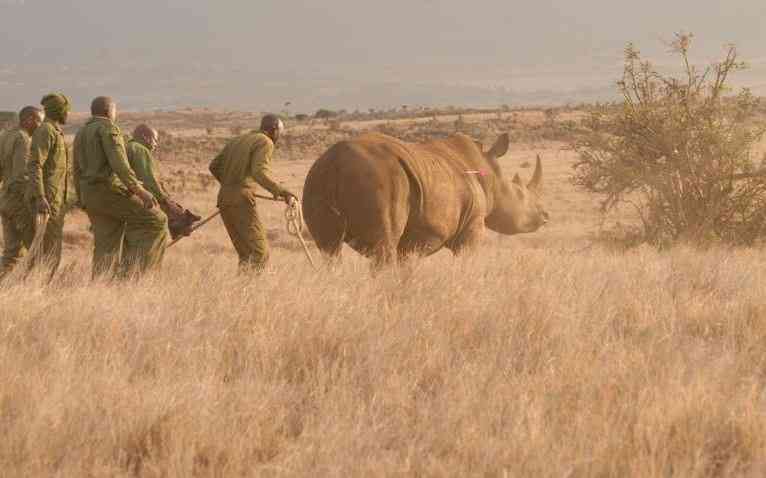
How many men does it take to corner and subdue a rhino? Close to 40 perhaps, especially the ill-tempered black rhino. But it can also take one man if that happens to be Dr Michael Njoroge, the Kenya Wildlife Service veterinary doctor.
With a single shot of a tranquilliser dart each, Njoroge was able to calm 40 rhinos during the 10-day long ear-notching exercise in the sprawling Lewa and Borana conservancies.
It was a week of high drama, witnessed by hordes of wildlife enthusiasts, conservationists, journalists and guests in some of the high-end lodges in northern Kenya.
One of the Big Five, - a group that includes the lion, elephant, buffalo, and leopard - the rhino is aptly described as the battle tank of the jungle. It can charge with little provocation, and change direction with the twinkling of an eye.
With poor eyesight, but an excellent sense of hearing and smell, a rhino can react swiftly to anything it perceives as a threat. These beasts are better watched from the safety of a vehicle.
But in Lewa, we tested fate, coming face to face with these beasts that had to go through this right of passage meant to protect them from poachers.
Ear notching is carried out after every two to three years in all rhino sanctuaries to ensure that at least 60 per cent of all rhinos are uniquely identifiable. Few activities are as adrenaline-sapping as watching a three-tonne animal submit to the will of man.
We had left the city on a sunny Monday morning with a brief pit stop at Sagana. The journey to northern Kenya is getting easier and easier with a good section of the Kenol-Marua dual carriageway open to the public, bringing those annoying traffic snarl-ups around Makuyu to an end.
The lush farmlands of central Kenya give way to what seems to be a bleak and windswept jungle that is northern Kenya.
But Lewa is one of the key landscapes where the endangered rhinos have been making a steady recovery. Of the 1,890 rhinos found in Kenya, Lewa is home to 200 or 13 per cent of the country's total.
But as their population increases, their habitat continues to shrink, bringing them, and other wild species within proximity of humans. An encounter between the two never ends well. Rhinos are always on the losing end.
Then there are the poachers and their rich backers who would not waste any second to kill off a rhino to remove the horn, prized as an aphrodisiac and ornamental use in parts of Asia. Those who harbour such ideas might as well chew their fingernails or hair trimmings because these contain keratin, the same substance found in rhino horn and with the same medicinal value - zero! To identify these animals and track their movements within the ecosystem, rhinos are ear-notched and electronic devices are inserted in selected animals. In this case, 10 rhinos were fitted with long-range (LoRa) transmitters that are tracked in the office via EarthRanger software for enhanced security surveillance and conservation.
That is the easier part though. Darting an unwilling rhino and getting it to lie down for the exercise that takes about 10 minutes is a herculean task. Few of us had witnessed such as task before and needed to get a front-row seat during the exercise.
At the crack of dawn, the medical team assembled under a canopy of acacia trees, the embers of the previous night's bonfire sending a column of smoke to the clear sky. A brief from the team leader, Dr Isaac Lekolool from Kenya Wildlife Service and Lewa's head of conservation Dr Dominic Maringa set the tone for the task ahead.
One of the most delicate exercises included preparing the darts, a task Njoroge handled with a surgeon's precision.
"A drop of this concoction can make you sleep for good," he warned us as he shook the mixture. We took a step back. "A dart that can make the bulky rhino sleep would be lethal to a human. It can make you sleep, but we have no way of waking you up."
In the field, unsuspecting rhinos fell prey to Njoroge's tricks. However, the more agile black rhino never went down without a fight and ran for miles across the plains, down the valleys and up the hills in the 62,000-acre conservancy with the pink-topped dart lodged in the rear end. Hunting it down with a helicopter was the only way to immobilise the brute.
The exception to this rule was Kitui, a black rhino hand-reared by Kamara, one of the rangers in Lewa and who had to get notched and a transmitter fitted.
He was just about to be reintegrated back into the wild and the gadgets would help the teams monitor his movements and mitigate expected conflicts with other rhinos.
On the other hand, the largely docile white rhino rarely put up a spirited fight. But all had to be approached with caution.
As soon as an animal went down, the team descended on the beast, each handling a particular task. An initial team marked the notch pattern with a pen and another team with scissors sliced the notch.
Another team sprayed an anti-bacterial medicine to ward off infections on the fresh notch. The rhinos even got a paint job in the form of a number painted on their backside to keep count of notched animals.
Some monitored the animal's vital organs such as the heart rate, breathing and temperature. If the temperature rose to alarming levels, another team cooled off the rhino with water.
Another team was busy drilling the horns of animals that needed to be fitted with digital transmitters. As soon as the all-clear sign was given by the team leader, an antidote had to be administered with the entire team hurrying back to their vehicles lest the animal woke up in a foul mood.
The military-like exercise over in record time, the rhino would lazily wake up, and like a man who has had some tipple, stagger for a while before finding its bearings. Some behaved like the inebriated animals in the motion picture, The Gods Must be Crazy in which animals partook too much of the fermenting fruit of the African marula tree.
The drowsy Lewa rhinos tried to vent their frustrations at the vehicles or any other object of their fancy. Within minutes though, they would sober up, and after making a few rounds, wander off into the wildlands, their haven.
 The Standard Group Plc is a multi-media organization with investments in media
platforms spanning newspaper print
operations, television, radio broadcasting, digital and online services. The
Standard Group is recognized as a
leading multi-media house in Kenya with a key influence in matters of national and
international interest.
The Standard Group Plc is a multi-media organization with investments in media
platforms spanning newspaper print
operations, television, radio broadcasting, digital and online services. The
Standard Group is recognized as a
leading multi-media house in Kenya with a key influence in matters of national and
international interest.



